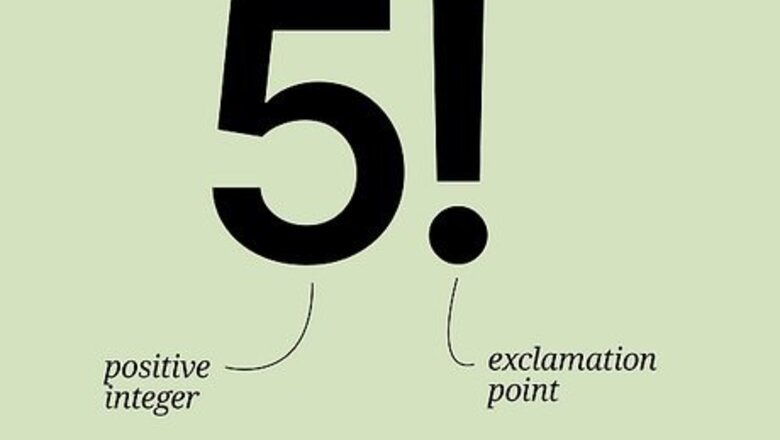
views
X
Research source
A factorial is denoted by a
!
{\displaystyle !}
sign, and it means to multiply together all the numbers descending from the factorial number. Once you understand what a factorial is, it is simple to compute, especially with the aid of a scientific calculator.
Computing a Factorial
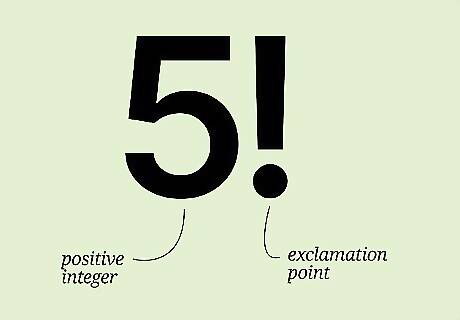
Determine the number you are computing the factorial for. A factorial is denoted by a positive integer and an exclamation point. For example, if you need to compute the factorial for 5, you will see 5 ! {\displaystyle 5!} 5!.

Write out the sequence of numbers to be multiplied. A factorial is simply multiplying the natural numbers that descend sequentially from the factorial number, down to 1. Speaking formulaically, n ! = n ( n − 1 ) ⋅ ⋅ ⋅ 2 ⋅ 1 {\displaystyle n!=n(n-1)\cdot \cdot \cdot 2\cdot 1} n!=n(n-1)\cdot \cdot \cdot 2\cdot 1, where n {\displaystyle n} n equals any positive integer. For example, if you are computing 5 ! {\displaystyle 5!} 5!, you would compute 5 ( 5 − 1 ) ( 5 − 2 ) ( 5 − 3 ) ( 5 − 4 ) {\displaystyle 5(5-1)(5-2)(5-3)(5-4)} 5(5-1)(5-2)(5-3)(5-4) or, denoted more simply: 5 ⋅ 4 ⋅ 3 ⋅ 2 ⋅ 1 {\displaystyle 5\cdot 4\cdot 3\cdot 2\cdot 1} 5\cdot 4\cdot 3\cdot 2\cdot 1.
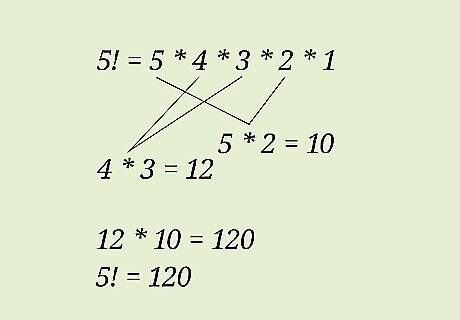
Multiply the numbers together. You can compute a factorial quickly using a scientific calculator, which should have a x ! {\displaystyle x!} x! sign. If you are computing by hand, to make it easier, first look for pairs of factors that multiply to equal 10. Of course, you can also ignore the 1, since any number multiplied by 1 equals that number. For example, if computing 5 ! = 5 ⋅ 4 ⋅ 3 ⋅ 2 ⋅ 1 {\displaystyle 5!=5\cdot 4\cdot 3\cdot 2\cdot 1} 5!=5\cdot 4\cdot 3\cdot 2\cdot 1, disregard the 1, and first calculate 5 ⋅ 2 = 10 {\displaystyle 5\cdot 2=10} 5\cdot 2=10. Now all you are left with is 4 ⋅ 3 = 12 {\displaystyle 4\cdot 3=12} 4\cdot 3=12. Since 10 ⋅ 12 = 120 {\displaystyle 10\cdot 12=120} 10\cdot 12=120, you know that 5 ! = 120 {\displaystyle 5!=120} 5!=120.
Simplifying a Factorial

Determine the expression you are simplifying. Often this will be stated as a fraction. For example, you might need to simplify 7 ! 5 ! ⋅ 4 ! {\displaystyle {\frac {7!}{5!\cdot 4!}}} {\frac {7!}{5!\cdot 4!}}.
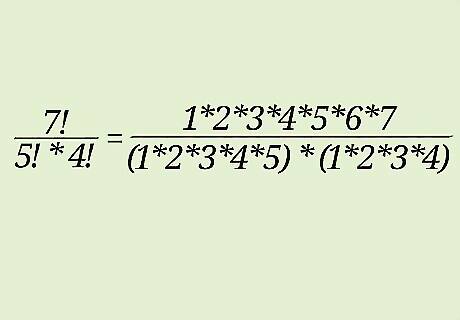
Write out the factors of each factorial. Since the factorial n ! {\displaystyle n!} n! is a factor of any factorial larger than it, to simplify, you need to look for factors that you can cancel out. This is easy to do if you write out each term. For example, if simplifying 7 ! 5 ! ⋅ 4 ! {\displaystyle {\frac {7!}{5!\cdot 4!}}} {\frac {7!}{5!\cdot 4!}}, rewrite as 1 ⋅ 2 ⋅ 3 ⋅ 4 ⋅ 5 ⋅ 6 ⋅ 7 ( 1 ⋅ 2 ⋅ 3 ⋅ 4 ⋅ 5 ) ⋅ ( 1 ⋅ 2 ⋅ 3 ⋅ 4 ) {\displaystyle {\frac {1\cdot 2\cdot 3\cdot 4\cdot 5\cdot 6\cdot 7}{(1\cdot 2\cdot 3\cdot 4\cdot 5)\cdot (1\cdot 2\cdot 3\cdot 4)}}} {\frac {1\cdot 2\cdot 3\cdot 4\cdot 5\cdot 6\cdot 7}{(1\cdot 2\cdot 3\cdot 4\cdot 5)\cdot (1\cdot 2\cdot 3\cdot 4)}}
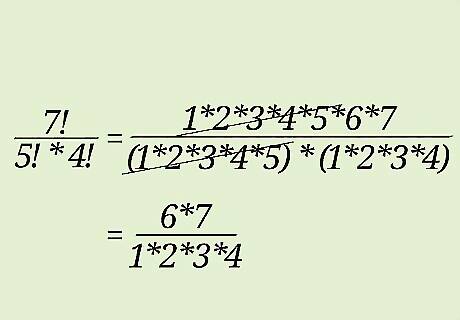
Cancel out any terms common to the numerator and denominator. This will simplify the numbers leftover that you need to multiply. For example, since 5 ! {\displaystyle 5!} 5! is a factor of 7 ! {\displaystyle 7!} 7!, you can cancel out 5 ! {\displaystyle 5!} 5! from the numerator and denominator: 1 ⋅ 2 ⋅ 3 ⋅ 4 ⋅ 5 ⋅ 6 ⋅ 7 ( 1 ⋅ 2 ⋅ 3 ⋅ 4 ⋅ 5 ) ⋅ ( 1 ⋅ 2 ⋅ 3 ⋅ 4 ) = 6 ⋅ 7 ( 1 ⋅ 2 ⋅ 3 ⋅ 4 ) {\displaystyle {\frac {{\cancel {1\cdot 2\cdot 3\cdot 4\cdot 5}}\cdot 6\cdot 7}{({\cancel {1\cdot 2\cdot 3\cdot 4\cdot 5}})\cdot (1\cdot 2\cdot 3\cdot 4)}}={\frac {6\cdot 7}{(1\cdot 2\cdot 3\cdot 4)}}} {\frac {{\cancel {1\cdot 2\cdot 3\cdot 4\cdot 5}}\cdot 6\cdot 7}{({\cancel {1\cdot 2\cdot 3\cdot 4\cdot 5}})\cdot (1\cdot 2\cdot 3\cdot 4)}}={\frac {6\cdot 7}{(1\cdot 2\cdot 3\cdot 4)}}

Complete the calculations. Simplify if possible. This will give you the final, simplified expression. For example: 6 ⋅ 7 ( 1 ⋅ 2 ⋅ 3 ⋅ 4 ) {\displaystyle {\frac {6\cdot 7}{(1\cdot 2\cdot 3\cdot 4)}}} {\frac {6\cdot 7}{(1\cdot 2\cdot 3\cdot 4)}} = 42 24 {\displaystyle ={\frac {42}{24}}} ={\frac {42}{24}} = 7 4 {\displaystyle ={\frac {7}{4}}} ={\frac {7}{4}}So, 7 ! 5 ! ⋅ 4 ! {\displaystyle {\frac {7!}{5!\cdot 4!}}} {\frac {7!}{5!\cdot 4!}} simplified is 7 4 {\displaystyle {\frac {7}{4}}} {\frac {7}{4}}.
Doing Sample Factorial Problems
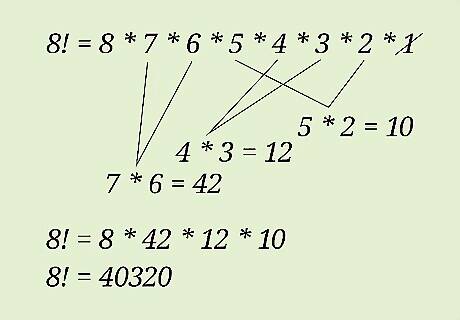
Evaluate the expression 8!. If using a scientific calculator, hit the 8 {\displaystyle 8} 8 key, followed by the x ! {\displaystyle x!} x! key. If solving by hand, write out the factors to be multiplied: 8 ⋅ 7 ⋅ 6 ⋅ 5 ⋅ 4 ⋅ 3 ⋅ 2 ⋅ 1 {\displaystyle 8\cdot 7\cdot 6\cdot 5\cdot 4\cdot 3\cdot 2\cdot 1} 8\cdot 7\cdot 6\cdot 5\cdot 4\cdot 3\cdot 2\cdot 1 Disregard the 1: 8 ⋅ 7 ⋅ 6 ⋅ 5 ⋅ 4 ⋅ 3 ⋅ 2 ⋅ 1 {\displaystyle 8\cdot 7\cdot 6\cdot 5\cdot 4\cdot 3\cdot 2{\cancel {\cdot 1}}} 8\cdot 7\cdot 6\cdot 5\cdot 4\cdot 3\cdot 2{\cancel {\cdot 1}} Pull out 5 ⋅ 2 {\displaystyle 5\cdot 2} 5\cdot 2: ( 5 ⋅ 2 ) 8 ⋅ 7 ⋅ 6 ⋅ 4 ⋅ 3 {\displaystyle (5\cdot 2)8\cdot 7\cdot 6\cdot 4\cdot 3} (5\cdot 2)8\cdot 7\cdot 6\cdot 4\cdot 3 = ( 10 ) 8 ⋅ 7 ⋅ 6 ⋅ 4 ⋅ 3 {\displaystyle =(10)8\cdot 7\cdot 6\cdot 4\cdot 3} =(10)8\cdot 7\cdot 6\cdot 4\cdot 3 Group any other easily multiplied numbers first, then multiply all the products together: ( 10 ) ( 4 ⋅ 3 ) ( 7 ⋅ 6 ) ( 8 ) {\displaystyle (10)(4\cdot 3)(7\cdot 6)(8)} (10)(4\cdot 3)(7\cdot 6)(8) = ( 10 ) ( 12 ) ( 42 ) ( 8 ) {\displaystyle =(10)(12)(42)(8)} =(10)(12)(42)(8) = ( 120 ) ( 336 ) {\displaystyle =(120)(336)} =(120)(336) = 40320 {\displaystyle =40320} =40320So, 8 ! = 40 , 320 {\displaystyle 8!=40,320} 8!=40,320.
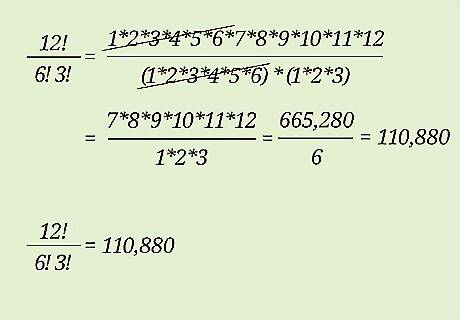
Simplify the expression: 12 ! 6 ! 3 ! {\displaystyle {\frac {12!}{6!3!}}} {\frac {12!}{6!3!}}. Write out the factors of each factorial: 1 ⋅ 2 ⋅ 3 ⋅ 4 ⋅ 5 ⋅ 6 ⋅ 7 ⋅ 8 ⋅ 9 ⋅ 10 ⋅ 11 ⋅ 12 ( 1 ⋅ 2 ⋅ 3 ⋅ 4 ⋅ 5 ⋅ 6 ) ( 1 ⋅ 2 ⋅ 3 ) {\displaystyle {\frac {1\cdot 2\cdot 3\cdot 4\cdot 5\cdot 6\cdot 7\cdot 8\cdot 9\cdot 10\cdot 11\cdot 12}{(1\cdot 2\cdot 3\cdot 4\cdot 5\cdot 6)(1\cdot 2\cdot 3)}}} {\frac {1\cdot 2\cdot 3\cdot 4\cdot 5\cdot 6\cdot 7\cdot 8\cdot 9\cdot 10\cdot 11\cdot 12}{(1\cdot 2\cdot 3\cdot 4\cdot 5\cdot 6)(1\cdot 2\cdot 3)}} Cancel out terms common to the numerator and denominator: 1 ⋅ 2 ⋅ 3 ⋅ 4 ⋅ 5 ⋅ 6 ⋅ 7 ⋅ 8 ⋅ 9 ⋅ 10 ⋅ 11 ⋅ 12 ( 1 ⋅ 2 ⋅ 3 ⋅ 4 ⋅ 5 ⋅ 6 ) ( 1 ⋅ 2 ⋅ 3 ) = 7 ⋅ 8 ⋅ 9 ⋅ 10 ⋅ 11 ⋅ 12 1 ⋅ 2 ⋅ 3 {\displaystyle {\frac {{\cancel {1\cdot 2\cdot 3\cdot 4\cdot 5\cdot 6\cdot }}7\cdot 8\cdot 9\cdot 10\cdot 11\cdot 12}{({\cancel {1\cdot 2\cdot 3\cdot 4\cdot 5\cdot 6}})(1\cdot 2\cdot 3)}}={\frac {7\cdot 8\cdot 9\cdot 10\cdot 11\cdot 12}{1\cdot 2\cdot 3}}} {\frac {{\cancel {1\cdot 2\cdot 3\cdot 4\cdot 5\cdot 6\cdot }}7\cdot 8\cdot 9\cdot 10\cdot 11\cdot 12}{({\cancel {1\cdot 2\cdot 3\cdot 4\cdot 5\cdot 6}})(1\cdot 2\cdot 3)}}={\frac {7\cdot 8\cdot 9\cdot 10\cdot 11\cdot 12}{1\cdot 2\cdot 3}} Complete the calculations: 7 ⋅ 8 ⋅ 9 ⋅ 10 ⋅ 11 ⋅ 12 1 ⋅ 2 ⋅ 3 {\displaystyle {\frac {7\cdot 8\cdot 9\cdot 10\cdot 11\cdot 12}{1\cdot 2\cdot 3}}} {\frac {7\cdot 8\cdot 9\cdot 10\cdot 11\cdot 12}{1\cdot 2\cdot 3}} = 665 , 280 6 {\displaystyle ={\frac {665,280}{6}}} ={\frac {665,280}{6}} = 110 , 880 {\displaystyle =110,880} =110,880So, the expression 12 ! 6 ! 3 ! {\displaystyle {\frac {12!}{6!3!}}} {\frac {12!}{6!3!}} simplifies to 110 , 880 {\displaystyle 110,880} 110,880.
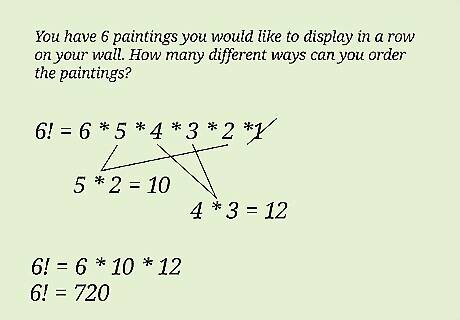
Try the following problem. You have 6 paintings you would like to display in a row on your wall. How many different ways can you order the paintings? Since you are looking for different ways you can order objects, you can simply solve by finding the factorial for the number of objects. The number of possible arrangements for 6 paintings hung in a row can be solved by finding 6 ! {\displaystyle 6!} 6!. If using a scientific calculator, hit the 6 {\displaystyle 6} 6 key, followed by the x ! {\displaystyle x!} x! key. If solving by hand, write out the factors to be multiplied: 6 ⋅ 5 ⋅ 4 ⋅ 3 ⋅ 2 ⋅ 1 {\displaystyle 6\cdot 5\cdot 4\cdot 3\cdot 2\cdot 1} 6\cdot 5\cdot 4\cdot 3\cdot 2\cdot 1 Disregard the 1: 6 ⋅ 5 ⋅ 4 ⋅ 3 ⋅ 2 ⋅ 1 {\displaystyle 6\cdot 5\cdot 4\cdot 3\cdot 2{\cancel {\cdot 1}}} 6\cdot 5\cdot 4\cdot 3\cdot 2{\cancel {\cdot 1}} Pull out 5 ⋅ 2 {\displaystyle 5\cdot 2} 5\cdot 2: ( 5 ⋅ 2 ) 6 ⋅ 4 ⋅ 3 {\displaystyle (5\cdot 2)6\cdot 4\cdot 3} (5\cdot 2)6\cdot 4\cdot 3 = ( 10 ) 6 ⋅ 4 ⋅ 3 {\displaystyle =(10)6\cdot 4\cdot 3} =(10)6\cdot 4\cdot 3 Group any other easily multiplied numbers first, then multiply all the products together: ( 10 ) ( 4 ⋅ 3 ) ( 6 ) {\displaystyle (10)(4\cdot 3)(6)} (10)(4\cdot 3)(6) = ( 10 ) ( 12 ) ( 6 ) {\displaystyle =(10)(12)(6)} =(10)(12)(6) = ( 120 ) ( 6 ) {\displaystyle =(120)(6)} =(120)(6) = 720 {\displaystyle =720} =720So, 6 paintings hung in a row can be ordered 720 different ways.
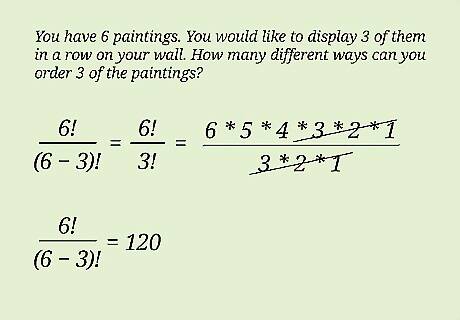
Try the following problem. You have 6 paintings. You would like to display 3 of them in a row on your wall. How many different ways can you order 3 of the paintings? Since you have 6 different paintings, but you are only choosing 3 of them, you only need to multiply the first 3 numbers in the sequence for the factorial of 6. You can also use the formula n ! ( n − r ) ! {\displaystyle {\frac {n!}{(n-r)!}}} {\frac {n!}{(n-r)!}}, where n {\displaystyle n} n equals the number of objects you are choosing from, and r {\displaystyle r} r equals the number of objects you are using. This formula only works if you have no repetitions (an object can’t be chosen more than once), and order does matter (that is, you want to find how many different ways things can be ordered). The number of possible arrangements for 3 paintings chosen from 6 and hung in a row can be solved by finding 6 ! ( 6 − 3 ) ! {\displaystyle {\frac {6!}{(6-3)!}}} {\frac {6!}{(6-3)!}}. Subtract the numbers in the denominator: 6 ! ( 6 − 3 ) ! {\displaystyle {\frac {6!}{(6-3)!}}} {\frac {6!}{(6-3)!}} = 6 ! 3 ! {\displaystyle ={\frac {6!}{3!}}} ={\frac {6!}{3!}} Write the factors of each factorial: 6 ⋅ 5 ⋅ 4 ⋅ 3 ⋅ 2 ⋅ 1 3 ⋅ 2 ⋅ 1 {\displaystyle {\frac {6\cdot 5\cdot 4\cdot 3\cdot 2\cdot 1}{3\cdot 2\cdot 1}}} {\frac {6\cdot 5\cdot 4\cdot 3\cdot 2\cdot 1}{3\cdot 2\cdot 1}} Cancel out terms common to the numerator and denominator: 6 ⋅ 5 ⋅ 4 ⋅ 3 ⋅ 2 ⋅ 1 3 ⋅ 2 ⋅ 1 {\displaystyle {\frac {6\cdot 5\cdot 4\cdot {\cancel {3\cdot 2\cdot 1}}}{\cancel {3\cdot 2\cdot 1}}}} {\frac {6\cdot 5\cdot 4\cdot {\cancel {3\cdot 2\cdot 1}}}{{\cancel {3\cdot 2\cdot 1}}}} Complete the calculations: 6 ⋅ 5 ⋅ 4 = 120 {\displaystyle 6\cdot 5\cdot 4=120} 6\cdot 5\cdot 4=120So, 3 paintings chosen from 6 can be ordered in 120 different ways if hung in a row.



















Comments
0 comment